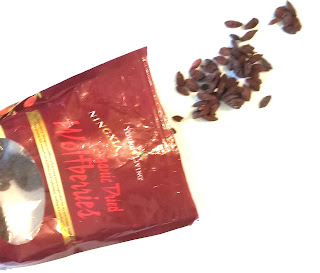Exploring Superfoods: Wolfberries
Have you ever noticed that the reported "superfoods" on the market are foods
you've never even heard of? Who eats Sacha inchi seeds? What's maca? Where do
you buy maqui berries?
When I first heard of the wolfberry from a former colleague and Young Living distributor, I thought this was some exotic fruit I'd never heard of.
The Basics
Nutrition
A lot of these
"superfoods" are not foods that you grew up on, if you ate the
Standard American Diet. That’s okay. We’ll explore them together.
Today, I want to introduce you to the wolfberry, one of the main ingredients in Young Living Ningxia Red products. This post contains affiliate links, if you choose to buy from Young Living.
Today, I want to introduce you to the wolfberry, one of the main ingredients in Young Living Ningxia Red products. This post contains affiliate links, if you choose to buy from Young Living.
When I first heard of the wolfberry from a former colleague and Young Living distributor, I thought this was some exotic fruit I'd never heard of.
The Basics
Well, it turns out that
I had eaten it before. A "wolfberry" is another name for a goji
berry. In China is is also known as Ningxia gǒuqi. The scientific name is Lycium barbarum or Lycium chinense.
The
two Lycium shrubs grow in different regions of China. Lycium
chinense grows in southern China and L. barbarum grows in the north
or Ningxia Hui Autonomous Region. The shrubs can also be found in Vietnam, Korea,
and Japan.
Both plants produce oblong reddish berries. The dried berries, seeds, leaves, root, and bark are all used in Traditional Chinese Medicine. However, most American grocery stores only sell the dried berries.
Both plants produce oblong reddish berries. The dried berries, seeds, leaves, root, and bark are all used in Traditional Chinese Medicine. However, most American grocery stores only sell the dried berries.
Traditional Uses
In
China, wolfberries are eaten raw, dried, or cooked in soup. They can also be
turned into juice and wine. Both the berries and the leaves are boiled to make
tea. For medicinal purposes, wolfberries can also be processed into tinctures,
tonics, tablets, and powder.
Traditional
Chinese Medicine involves the concept of yin and yang, sometimes called cold
and hot or moist and dry respectively. For example, since fever is seen as a
yin deficiency because someone is hot, which is a yang trait.
The wolfberry
products are used when someone might be deficient in yin. In Traditional Chinese Medicine, wolfberries may be used to treat a wide variety of
ailments, improve energy, and increase
lifespan*. (Read more at Potterat 2010)
Nutrition
One of the reasons wolfberries are called a superfood is their high polyphenol content. Polyphenols have antioxidant properties. They can be found in a lot of other plants and plant-based products. This is why you may have heard that tea, coffee, chocolate, and wine have health benefits; they all contain polyphenols. You can also find polyphenols in most fruit.
Besides polyphenols, wolfberries provide fiber, calcium, iron, vitamin C, vitamin A, and potassium (USDA).
How To Use
Dried wolfberries can be used in cooking in place of other dried fruits, like raisins. Use in oatmeal cookies, trail mix, granola, smoothie bowls, and more.
To make tea, line the bottom of a mug with dried wolfberries. Pour boiling water over top and allow to steep at least 5 minutes before drinking.
Some companies also offer wolfberry supplements in capsule and powder forms. The powder can be mixed into smoothies, yogurt, or other foods.
Young Living offers a line of wolfberry-based drinks, called NingXia. NingXia Red combines wolfberry puree with other superfoods, like pomegranate juice and cherry juice. It comes in both bottles and juice pouches. NingXia Nitro and NingXia Zyng are more like energy drinks, with caffeine from green tea extract and white tea extract respectively.
NingXia drinks can be consumed alone or in recipes, like smoothies and mocktails. Try these kid-friendly NingXia Red shots.
*These statements have not been evaluated by the Food and Drug Administration. These products are not intended to diagnose, treat, cure, or prevent disease.
To make tea, line the bottom of a mug with dried wolfberries. Pour boiling water over top and allow to steep at least 5 minutes before drinking.
Some companies also offer wolfberry supplements in capsule and powder forms. The powder can be mixed into smoothies, yogurt, or other foods.
Young Living offers a line of wolfberry-based drinks, called NingXia. NingXia Red combines wolfberry puree with other superfoods, like pomegranate juice and cherry juice. It comes in both bottles and juice pouches. NingXia Nitro and NingXia Zyng are more like energy drinks, with caffeine from green tea extract and white tea extract respectively.
NingXia drinks can be consumed alone or in recipes, like smoothies and mocktails. Try these kid-friendly NingXia Red shots.
*These statements have not been evaluated by the Food and Drug Administration. These products are not intended to diagnose, treat, cure, or prevent disease.







